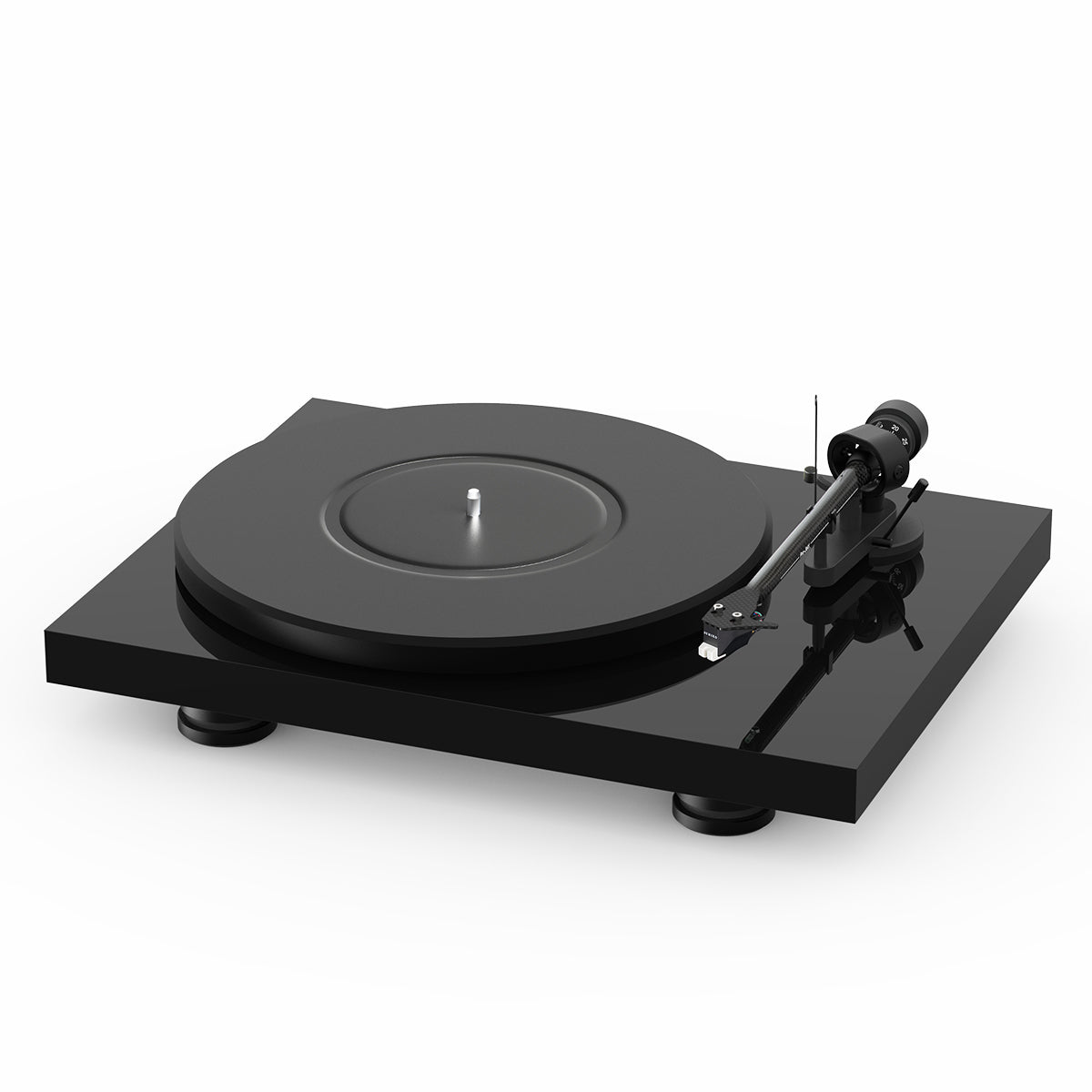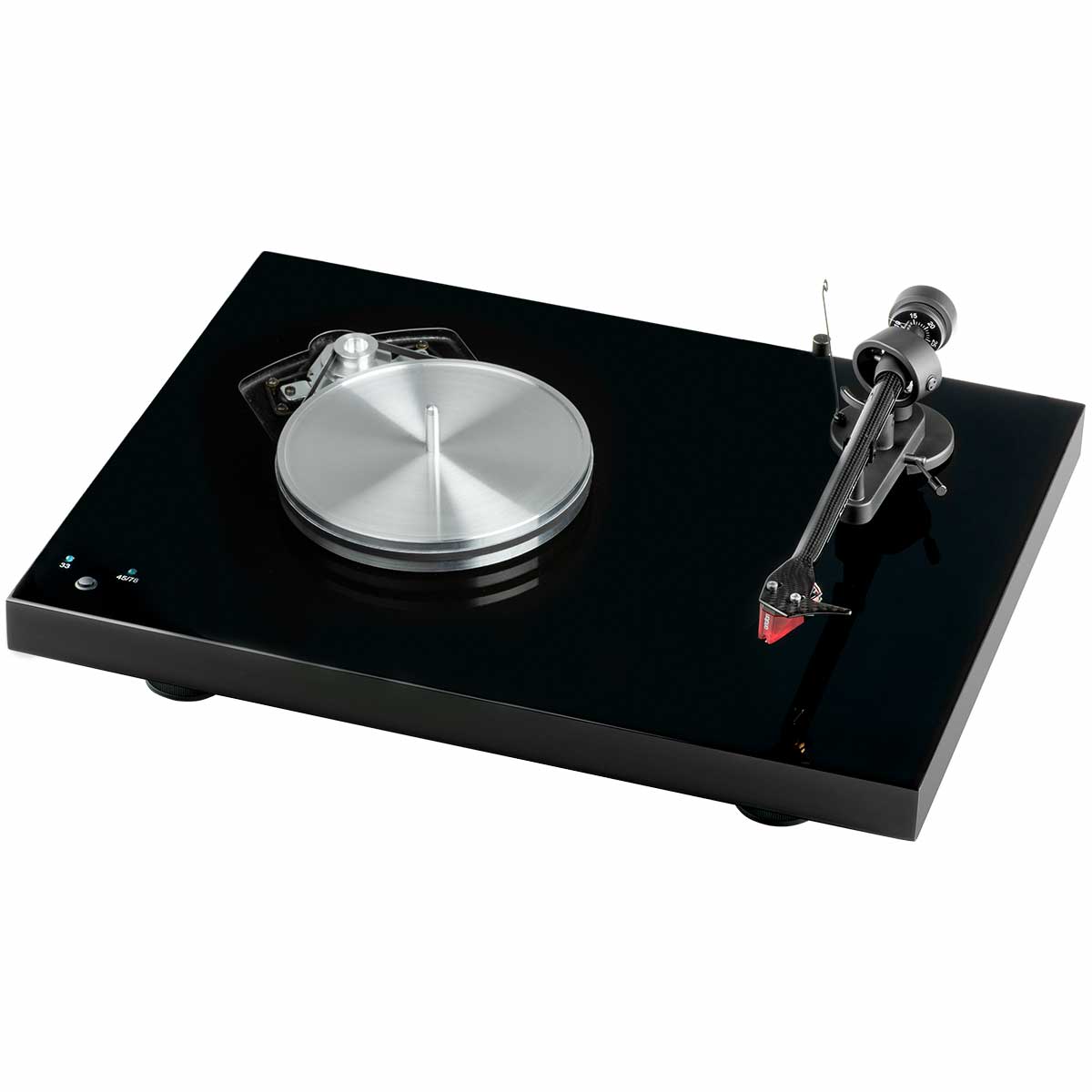Debut PRO vs Debut Carbon EVO
PRO-JECT TURNTABLE COMPARISON

The original Pro-Ject Debut turntable is without question one of the best-selling turntables of all time. It has gone through several revisions to improve its performance over its 30-year history.
Since their humble beginnings in 1991, Pro-Ject Audio Systems has grown to become one of the largest suppliers of performance two-channel audio components in the world. Pro-Ject is quite unique in this age of globalization in that they make everything from scratch. They are headquartered just north of Vienna in a 131,000 sq ft facility that is one of the most environmentally friendly buildings we have ever seen. They also have turntable-specific plants in Germany and the Czech Republic, with two other factories for electronics in Slovakia. . We have to compliment them on keeping everything in-house as it has certainly proven successful over time with Pro-Ject components lasting for decades.
In 2020, Pro-Ject released the latest version — the Debut Carbon EVO. The first time we played around with the EVO, we could tell it was going to be an outstanding value. We also love the way Pro-Ject gives up an upgrade path on the Debut line to make it sound even better over time.
For the 30th anniversary of the original Pro-Ject turntable, Pro-Ject has introduced a new audiophile-grade model called the Debut PRO. When you first look at the Debut PRO compared to the EVO, you will notice some differences, however, in some areas the two tables seem pretty similar.

We thought it would be fun to dive into the PRO and see how it compares to the EVO to help you make a better decision if you are considering something like the EVO or better.
Watch our full review of the Pro-Ject Debut Carbon EVO for an in-depth deep dive and overview of the specs & features offered. Debut Carbon EVO
When you look at the Debut PRO, it becomes obvious that Pro-Ject used all of the great features incorporated into the EVO as a marvelous foundation, and then added two additional upgrades for the most critical parts of any turntable.
The EVO just offers so much for the money, we would be remiss if we did not briefly review some of the technologies you’ll find carried over from the EVO into the PRO.
The isolation feet used on both models incorporate TPE (thermoplastic elastomer) damping material. This material greatly reduces resonance and we like the fact the feet are pretty large and are height adjustable too!
Pro-Ject took some tech from their add-on Speed Box and added it to the motor control for both models. A precision crystal is used to generate the signal that goes to the motor, which gives it great speed accuracy. Getting something like this for the price range of either of these tables is pretty amazing. Both tables give you a way to easily switch between 33 and 45 without having to change the belt. And for 78 lovers, you can switch out the belt and play 78’s too! The EVO hides the switch on the underside of the plinth while the PRO has a little toggle switch on top.
Speaking of the plinth, they are made of the same material, but Pro-Ject decided to make the PRO in a basic black finish, while the EVO can be had in 9 different colors.


When Pro-Ject updated the EVO, they made a massive change to the motor and mount they took from their upper-end X1 turntable. They added a large steel plate to better shield the platter from the motor. The mounting plate then gets TPE washers on both sides to keep any vibrations of the motor from making it into the tonearm bearing well. Both the PRO and EVO have the same isolation system.
The US version of the EVO includes the Sumiko Rainier phono cartridge. Sumiko is the US importer of Pro-Ject and set out several years ago to design a budget-friendly series of phono cartridges that had far greater performance than you would expect for their cost. They worked with a team of engineers in Yokohama, Japan to come up with 3 new models. These have been heralded by reviewers all over the world for their very musical sound. We like the way they all use the same anti-resonant body and special generator, but get a much better stylus tip as you move up the line. This way, when your Rainier stylus needs replacing, you can upgrade by purchasing either a Moonstone or Olympia stylus. And for 78 fans, you can purchase a 78 stylus to use with the Rainier for your 78’s, The stylus just slides in and out pretty easily.

.jpg?v=1724955548559)
The PRO also uses the Rainier, which for us, made comparing these two models a very interesting listening experience.
Both the PRO and EVO share the same high-performance connectors and include the Connect-E cable. The rear panel has two solid gold-plated RCA connectors. This allows you to upgrade the included cable should you wish, but Pro-Ject gives you a good one. The Connect-E comes with their much more advanced turntables. It even has a specific length they found to sound best at 1.23 meters.
Two of the most important aspects of any turntable are the tonearm and platter. This is where the PRO takes a big jump up from the EVO.
The EVO platter is a 4-pound piece of steel with a TPE damping ring on the outer edge. This is a fantastic platter for a turntable in this price range. The PRO changes to a one-piece aluminum platter. The outer edge now has another ring inside the TPE ring for an even better flywheel effect. The center of the platter is indented just slightly for using the optional add-on PRO record weight.
.jpg?v=1724955660149)
Another important distinction between aluminum and steel is you can now install moving coil cartridges on the PRO. Steel platters just do not play well with moving coils and their powerful magnets.
The huge jump in audio performance is the tonearm. The job of a tonearm is to simply support your phono cartridge as its stylus traces the grooves of the record. It should be friction-free in both the vertical and horizontal plane and add zero noise. When you think about how microscopic the grooves of a record are, this task is a lot harder than it sounds. This is why you find at the very extreme of audio some tonearms that cost more than a nice car. It takes great engineering and precision manufacturing to produce a great tonearm.
Pro-Ject has the benefit of their own in-house CNC machines to make anything they want to incredibly tight standards. The bearing housing starts out as a single block of aluminum and is precision cut to extreme tolerances. We love to play around with tonearms to see if we can find any bearing chatter and found that while the PRO is not perfect, it has far less than the EVO arm.
The tonearm tube is made out of a sandwich-type construction with an aluminum tube on the inside to damp out vibrations and is wrapped in carbon fiber for strength. The counterweight even has internal damping inside its shell to help reduce any resonance.

The final icing on the cake is the fact both vertical tracking angle and azimuth adjustments are on the PRO arm, a first for a Debut model. This means you can put just about any cartridge you want on it and get it fine-tuned.
We set up both turntables on a high-performance two-channel audio system to enable us to hear the differences the tonearm and platter would make on the PRO if any. We checked out the stylus on both tables under a microscope to confirm they looked the same. Then we checked the alignment on both using the Pro-Ject gauge. Next, we confirmed they were both set precisely to 2 grams tracking force. We do have to call out the PRO here though — it was extremely finicky to get the tracking set just right as tiny changes on the counterweight make a big move. This made us decide to create a tips & tricks video on how to set up the PRO that we will provide to Audio Advice customers to help get everything perfect.
To further geek out, we physically moved the same external power supply back and forth between the two, along with the Connect-E tonearm cable. At this point, we were sure any differences we would detect would be related to the arm and platter improvements.
To do our testing, we pulled out some vinyl with challenging sections from both a tracking perspective and a rhythm and pacing test. These were a 2020 great repressing of the first track on Joan Armatrading’s title album, “Down to Zero”, Robert Cray’s “Smoking Gun” from Strong Persuader for tracking, and our favorite rhythm and pacing test, John Cougar Mellencamp Uh-Huh “Pink Houses”.
We first played the EVO and were once again amazed at how great this table sounds for the money. It really is incredible. However, after the first Joan Armatrading cut, when we switched to the PRO, it was an entirely different ballgame. We hate to be so blunt, but it made the EVO sound like it was mistracking in comparison. Her voice was so much smoother with zero traces of sibilance that we had heard a little of it on the EVO. Everything sounded much more effortless as well. As we kept flipping back and forth on this cut, it became clear, there was just less distortion on the PRO, which gave it a smoother and sweeter sound.
Moving on to “Smoking Gun”, we heard similar changes on the guitar although they were not as obvious as on the female voice on the first cut. But, the whole character was warmer and more free-flowing on the PRO.
Finally, “Pink Houses” had our toes tapping pretty well on the EVO, but switching to the PRO brought in extra warmth, a bigger sound field, and an even better feeling of the band being in the room. The specs on the PRO vs the EVO also point this out as both the speed drift and wow and flutter measurements are better on the PRO due to the flywheel effect of the improved platter.
As we have said many times, the Debut Carbon EVO is just an amazing turntable for its cost. The fact that there are so many upgrades available, including the stylus, is very impressive. However, all of those same upgrades can apply to the Debut PRO, including moving to a much higher-end moving coil cartridge design due to the aluminum platter and fully adjustable arm.
On a good system, we think the difference will be obvious to most people with less distortion and a smoother, bigger, and more fun to listen to an analog presentation.
Remember, the sound begins at your turntable and if it is not captured there, nothing else in your chain can bring it back.
We hope this overview will give you a good idea of the differences between the EVO and the PRO. If you have any questions at all, please feel free to reach out to us at www.audioadvice.com via phone, email, or chat, or visit one of our stores.
You'll be among the first to know about product launches, exclusive online deals, and the hottest audio trends.




